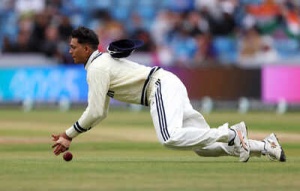Former England seamer Stuart Broad has lauded Indian bowler Akash Deep for his impressive performance in the second Test. Broad highlighted Akash Deep's effectiveness, particularly his ability to target the stumps, which made him a greater threat compared to the England pacers on the Edgbaston pitch.

Akash Deep celebrates taking the wicket of Joe Root.
"He brings the stumps into play, nips the ball, even with the second new ball with Harry Brook (in the first innings), through the gate and off stump out of the ground," Broad commented on Sky Sports.
Broad emphasized the importance of utilizing Akash Deep strategically. "He's a real threat and, you know, India have to use him wisely again on the final day. He's bowled wicket-taking balls tonight. Start with him tomorrow while the ball's hard and while the ball's still got a bit of newness to it, and then maybe if he needs a rest until the next new ball comes, that's fine," Broad stated.
Furthermore, Broad pointed out how Akash Deep's adept use of the crease contributed to dismissing Joe Root in the second innings.
"Using the crease. It's crucial. It's a skill and an art that every Test match bowler should have," Broad explained. "Every bowler should have it really. I mean, how I used to sort of view it was a batter will always line up the same to you."
Video: Morkel praises Siraj's passionate performance.
He elaborated on how subtle adjustments in release position can significantly impact a batsman's response. "If you can change your release position by a couple of inches at a time, they're not necessarily turning their shoulders or their feet position. So that little movement can be that half-bat-width distance that can catch the edge or make them miss it and hit the stump."
Broad advised bowlers to practice varying their angles. "You should practise that in the nets, and if you're going to play league cricket this weekend, just practise changing your angles just slightly at the back end of your run. Just go a foot wider but still imagine you're running in at off stump and just work with that, because if there's no swing in the air, you suddenly get a different angle that you can work with."
Newer articles
Older articles
 Evil Eye Amulet: Protective Charm or Portal to Dark Forces? A Cultural Debate
Evil Eye Amulet: Protective Charm or Portal to Dark Forces? A Cultural Debate
 Jayden Seales Fined by ICC for Provocative Gesture During Australia Test Match
Jayden Seales Fined by ICC for Provocative Gesture During Australia Test Match
 Paralympic Archer Sheetal Devi's Viral Video Shows Her Driving Car with Feet, Defying Expectations
Paralympic Archer Sheetal Devi's Viral Video Shows Her Driving Car with Feet, Defying Expectations
 Broad Slams India's Team Selection After Headingley Test Loss, Calls for Roster Tweaks at Edgbaston
Broad Slams India's Team Selection After Headingley Test Loss, Calls for Roster Tweaks at Edgbaston
 Umpire Controversy Erupts: West Indies Coach Sammy Questions Holdstock's Consistency in Barbados Test
Umpire Controversy Erupts: West Indies Coach Sammy Questions Holdstock's Consistency in Barbados Test
 Sachin Tendulkar: 1983 World Cup Win Sparked My Cricket Dream at Age 10
Sachin Tendulkar: 1983 World Cup Win Sparked My Cricket Dream at Age 10
 Jaiswal's Fielding Woes: Ex-India Star Kaif Points to Potential Cause for Dropped Catches in England Test
Jaiswal's Fielding Woes: Ex-India Star Kaif Points to Potential Cause for Dropped Catches in England Test
 Team India's England Tour: Rahul's Sleep Strategy, Coaching Rituals, and Coffee Culture Revealed
Team India's England Tour: Rahul's Sleep Strategy, Coaching Rituals, and Coffee Culture Revealed
 Suryakumar Yadav Successfully Completes Sports Hernia Surgery, Eyes Return to Cricket
Suryakumar Yadav Successfully Completes Sports Hernia Surgery, Eyes Return to Cricket
 Gujarat Cricket Set to Launch T20 League in 2025-26 Season
Gujarat Cricket Set to Launch T20 League in 2025-26 Season